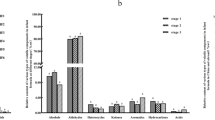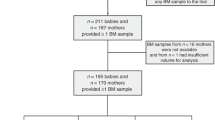Abstract
It has been suggested that mother’s milk has a more diverse flavor composition than infant formula milk as it reflects the maternal diet. This study aimed to identify volatile compounds in mother’s milk and infant formula milks to obtain more knowledge about these sources of early sensory exposure in infant feeding. Mother’s milk collected by ten lactating women, three times on three independent test days (n = 90), and 11 different formula milks were examined. Formulas included seven milk-based liquid formulas and four powder formulas (one milk-based and three hypoallergenic). Both mother’s milk and infant formulas were rich in lipid-derived volatile compounds including alcohols and carbonyl compounds. Formulas differed from mother’s milk as they contained more volatiles related to thermal treatment such as methional, 2-furfural, and sulfides. By comparison, mother’s milk revealed a higher variety of terpenes probably originating from the maternal diet. The number of identified volatiles in mother’s milk varied both within samples obtained from the same woman and significantly between women. The latter one suggests large variety in breast-fed infants’ exposure to volatiles. Qualitative differences existed for infant formulas. Powder forms revealed a greater number of compounds, predominantly secondary lipid oxidation products, and larger batch variations than liquid products. Extensively hydrolyzed formulas were significantly richer in volatile compounds associated with heat treatment of milk. These findings suggest that breast-fed infants are exposed to variations in volatile compounds in mother’s milk, while formula-fed infants are exposed to less diverse flavors when fed infant formula from the same brand.


Similar content being viewed by others
Abbreviations
- AL:
-
Allomin
- AP:
-
Aptamil
- FA:
-
Farley’s
- LRI:
-
Linear Retention Index
- NH:
-
NAN H.A
- NU:
-
Nutramigen
- PC:
-
Principal Component
- PCA:
-
Principal Components Analysis
- PR:
-
Profylac
- UHT:
-
Ultra-High Temperature
References
Albalá-Hurtado S, Veciana-Nogues MT, Izquierdo-Pulido M, Vidal-Carou MC (1997) Determination of free and total furfural compounds in infant milk formulas by high-performance liquid chromatography. J Agric Food Chem 45:2128–2133
Albalá-Hurtado S, Veciana-Nogues MT, Marine-Font A, Vidal-Carou MC (1998) Changes in furfural compounds during storage of infant milks. J Agric Food Chem 46:2998–3003
Arai S (1980) The bitter flavor due to peptides or protein hydrolysates and its control by bitter-masking with acidic oligopeptides. In: Charalambus G (ed) The analysis and control of less desirable flavors in foods and beverages. Academic, London, pp 133–147
Badings HT, Neeter R (1980) Recent advances in the study of aroma compounds of milk and dairy products. Neth Milk Dairy J 34:9–30
Badings HT (1991) Milk. In: Maarse H (ed) Volatile compounds in foods and beverages. Marcel Dekker, New York, pp 91–106
Baltussen E, Sandra P, David F, Cramers C (1999) Stir bar sorptive extraction (SBSE), a novel extraction technique for aqueous samples: theory and principles. J Microcolumn Sep 11:737–747
Bendall JG (2001) Aroma compounds of fresh milk from New Zealand cows fed different diets. J Agric Food Chem 49:4825–4832
Bingham PM, Stevens-Tuttle D, Lavin E, Acree T (2003) Odorants in breast milk. Arch Pediatr Adolesc Med 157:1031
Birch LL (2002) Acquisition of food preferences and eating patterns in children. In: Anderson H, Blundell J, Chiva M (eds) Food selection: from genes to culture. Institute Danone, Levallois-Perret, pp 71–84
Brown WH, Foote CS (2002) Alkanes I. Organic chemistry. Thomson Learning, New York, pp 159–180
Buettner A (2007) A selective and sensitive approach to characterize odour-active and volatile constituents in small-scale human milk samples. Flavour Fragr J 22:465–473
Burdock GA, Furia TE, Bellanca N (1994) Fenaroli’s handbook of flavor ingredients: adapted from the Italian language works of Giovanni Fenaroli. CRC, Boca Raton, FL
Cashdan E (1994) A sensitive period for learning about food. Human Nat 5:279–291
Fenaille F, Visani P, Fumeaux R, Milo C, Guy PA (2003) Comparison of mass spectrometry-based electronic nose and solid phase microextraction gas chromatography–mass spectrometry technique to assess infant formula oxidation. J Agric Food Chem 51:2790–2796
Ferrer E, Alegria A, Farre R, Abellan P, Romero F (2002) High-performance liquid chromatographic determination of furfural compounds in infant formulas: changes during. J Chromatogr A 947:85–95
Ferrer E, Alegria A, Farre R, Abellan P, Romero F (2005) High-performance liquid chromatographic determination of furfural compounds in infant formulas during full shelf-life. Food Chem 89:639–645
Ganchrow JR, Mennella JA (2003) The ontogeny of human flavor perception. In: Doty R (ed) Handbook of olfaction and gustation. Marcel Dekker, New York, pp 823–846
Hausner H, Bredie WLP, Mølgaard C, Petersen MA, Møller P (2008) Differential transfer of dietary flavour compounds into human breast milk. Physiol Behav 95:118–124
Havemose M, Justesen P, Bredie W, Nielsen JH (2007) Measurement of volatile products from milk using solvent-assisted flavour evaporation and solid phase microextraction. Int Dairy J 17:746–752
Hidalgo FJ, Gallardo E, Zamora R (2005) Strecker type degradation of phenylalinine by 4-hydroxy-2-nonenal in model systems. J Agric Food Chem 53:10254–10259
Jäger W, Mayer M, Reznicek G, Buchbauer G (2000) Percutaneous absorption of the monoterpene carvone: implication of stereoselective metabolism on blood levels. J Pharm Pharmacol 53:637–642
Jiang T, Schaal B, Marlier L, Soussignan R (1999) The food-related odor environment of French newborns: human and formula milk odors compared by adult nose. Chem Senses 24:80
Larráyoz P, Addis M, Gauch R, Bosset JO (2001) Comparison of dynamic headspace and simultaneous distillation extraction techniques used for the analysis of the volatile components in three European PDO ewes’ milk cheeses. Int Dairy J 11:911–926
Lauritzen L, Halkjær LB, Mikkelsen TB, Olsen SF, Michaelsen KF, Loland L, Bisgaard H (2006) Fatty acid composition of human milk in atopic Danish mothers. Am J Clin Nutr 84:190–196
Lauritzen L, Jørgensen MH, Hansen HS, Michaelsen KF (2002) Fluctuations in human milk long-chained PUFA levels in relation to dietary fish intake. Lipids 37:237–244
Maier A, Chabanet C, Schaal B, Issanchou S, Leathwood P (2007) Effects of repeated exposure on acceptance of initially disliked vegetables in 7-months old infants. Food Qual Prefer 18:1023–1032
McDaniel MR (1980) Off-flavors of human milk. In: Charalambus G (ed) The analysis and control of less desirable flavors in foods and beverages. Academic, London, pp 267–293
McManaman JL, Neville MC (2003) Mammary physiology and milk secretion. Adv Drug Deliv Rev 55:629–641
Mennella JA, Beauchamp GK (1991a) Maternal diet alters the sensory qualities of human milk and the nursling’s behavior. Pediatrics 88:737–744
Mennella JA, Beauchamp GK (1991b) The transfer of alcohol to human milk. Effects on flavor and the infant’s behavior. N Engl J Med 325:981–985
Mennella JA, Beauchamp GK (1993) The effects of repeated exposure to garlic-flavored milk on the nursling’s behavior. Pediatr Res 34:808
Mennella JA, Beauchamp GK (1996) The human infants’ response to vanilla flavors in mother’s milk and formula. Infant Behav Dev 19:13–19
Mennella JA, Beauchamp GK (1999) Experience with a flavor in mother’s milk modifies the infant’s acceptance of flavored cereal. Dev Psychobiol 35:197–203
Mennella JA, Beauchamp GK (2005) Understanding the origin of flavor preferences. Chem Senses 30:i242–i243
Mennella JA, Griffin CE, Beauchamp GK (2005) Flavor programming during infancy. Pediatrics 113:840–845
Mennella JA, Griffin CE, Beauchamp GK (2004) Flavor programming during infancy. Pediatrics 113:840–845
Mennella JA, Jagnow CP, Beauchamp GK (2001) Prenatal and postnatal flavor learning by human infants. Pediatrics 107:E88
Nijssen B (1991) Milk. In: Maarse H (ed) Volatile compounds in foods and beverages. Marcel Dekker, New York, pp 107–177
Pedrosa M, Pascual CY, Larco JI, Esteban MM (2006) Palatability of hydrolysates and other substitution formulas for cow’s milk-allergic children: a comparative study of taste, smell, and texture evaluated by healthy volunteers. J Investig Allergol Clin Immunol 16:351–356
Romeu-Nadal M, Castellote AI, Lopez-Sabater MC (2004) Headspace gas chromatographic method for determining volatile compounds in infant formulas. J Chromatogr 1046:235–239
Shibamoto T (1980) Flavor volatiles formed by heated milk. In: Charalambus G (ed) The analysis and control of less desirable flavors in foods and beverages. Academic, London, pp 241–265
Shimoda M, Yoshimura T, Ishikawa H, Hayakawa I, Osajima Y (2000) Volatile compounds of human milk. J Fac Agric Kyushu Univ 45:199–206
Singh TK, Young ND, Drake MA, Cadwallader KR (2005) Production and sensory characterization of a bitter peptide from beta-casein. J Agric Food Chem 53:1185–1189
Stafford M, Horning MG, Zlatkis A (1976) Profiles of volatile metabolites in body fluids. J Chromatogr 126:495–502
Sullivan SA, Birch LL (1994) Infant dietary experience and acceptance of solid foods. Pediatrics 93:277
Thomsen MK (2005) Lactose crystallization, Maillard reactions and lipid oxidation in milk powder. Department of Food Science, The Royal Veterinary and Agricultural University, Copenhagen, Denmark
Thomsen MK, Knudsen JC, Risbo J, Skibsted L (2003) Effect of lactose crystallisation on the oxidative stability of infant formula. Milchwissenschaft 58:406–409
Tornambe G, Cornu A, Pradel P, Kondjoyan N, Carnat AP, Petit M, Martin B (2006) Changes in terpene content in milk from pasture-fed cows. J Dairy Sci 89:2309–2319
Ullrich F, Grosch W (1987) Identification of the most intense volatile flavor compounds formed during autooxidation of linoleic-acid. Z Lebensm Unters Forsch 184:277–282
van Ruth SM, Floris V, Fayoux S (2006) Characterisation of the volatile profiles of infant formulas by proton transfer reaction–mass spectrometry and gas chromatography–mass spectrometry. Food Chem 98:343–350
Viallon C, Martin B, Verdier-Metz I, Pradel P, Garel JP, Coulon JB, Berdague JL (2000) Transfer of monoterpenes and sesquiterpenes from forage into milk fat. Lait 80:635–641
Zamora R, Gallardo E, Hidalgo FJ (2007) Strecker degradation of phenylalenine initiated by 2, 4-decadienal or methyl 13-oxooctadeca-9, 11-dienoate in model systems. J Agric Food Chem 55:1308–1314
Acknowledgment
The authors would like to thank all the mothers who participated in the study. Furthermore, we acknowledge Mehdi Darestani Farahani for his technical assistance.
Author information
Authors and Affiliations
Corresponding author
Rights and permissions
About this article
Cite this article
Hausner, H., Philipsen, M., Skov, T.H. et al. Characterization of the Volatile Composition and Variations Between Infant Formulas and Mother’s Milk. Chem. Percept. 2, 79–93 (2009). https://doi.org/10.1007/s12078-009-9044-6
Received:
Accepted:
Published:
Issue Date:
DOI: https://doi.org/10.1007/s12078-009-9044-6




